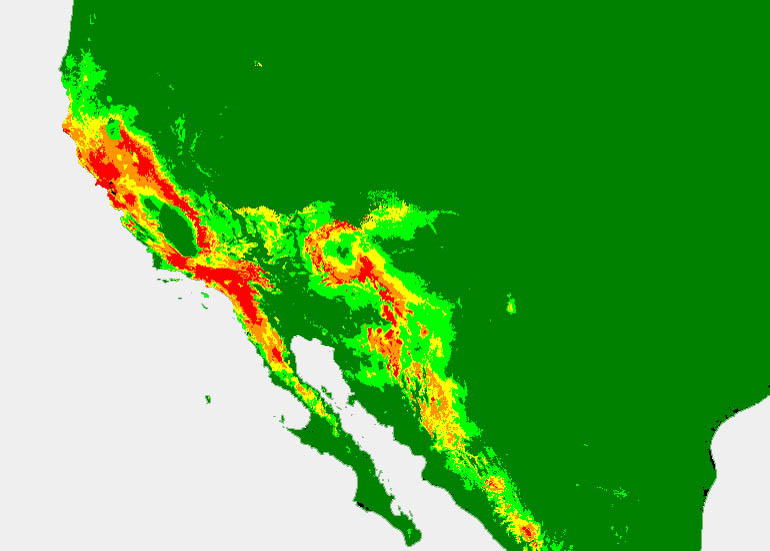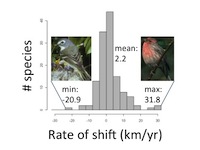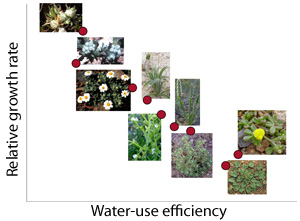Research projects

Range limits
Every species occupies a limited geographic area, but the ecological and evolutionary factors that give rise to range limits remain poorly understood. We are working to determine how dispersal limitation, abiotic factors, and biotic interactions interact to create present-day range limits. When ecological limiting factors are identified, range boundaries still present an evolutionary conundrum. If populations are maladapted to environmental conditions beyond the range, then why don't they evolve by natural selection and expand their ranges through time? To address these questions, we combine a variety of approaches, including demographic modeling of central and marginal population dynamics, growth chamber studies to examine physiological responses to limiting environmental variables, experimental transplants to evolve populations beyond range boundaries, and population genomics to infer gene flow across species’ ranges.
Sample publications

Range-shift forecasting
Although ranges might be evolutionarily stable with respect to limiting ecological factors, their positions on the landscape are sometimes highly labile as climate changes. Many studies have documented poleward or altitudinal range shifts over the last century, but there is considerable variation among species in range shifts observed to date and tremendous uncertainty about species’ capacities to continue keeping pace with rapid climate change. We are involved in several projects that may help address some of this uncertainty, including “hindcasting” recent range shifts and developing distribution models that incorporate factors such as dispersal limitation, species interactions, and local adaptation. In collaboration with Janneke Hille Ris Lambers, we have recently begun resurveying legacy vegetation plots in the Cascades to dissect recent range shifts in understory plant communities along elevation gradients.
Sample publications

Range size and rarity
Although every species has a limited distribution, some species have much more limited ranges than others. We are extending our research on geographic range limits to investigate the evolutionary ecology of range size and rarity in Mimulus, a genus where species vary in range size by several orders of magnitude. We are using a comparative phylogenetic framework to address questions such as what mating system, life history, or physiological traits are associated with small range size? We are also using empirical approaches to address questions such as, do rare species have narrow environmental tolerances, and if so, what constrains the evolution of broader tolerance? Are widespread species highly plastic, specialized to a common environment, or composed of many locally adapted populations?
Sample publications

Ecological speciation and niche evolution
Recently diverged sister taxa often have non-overlapping (allopatric) or abutting (parapatric) geographic distributions. Questions about range limits are intimately related to the geography of speciation and the process of ecological divergence from a common ancestor. The evolution of ecological differences in different geographic regions can contribute to reproductive isolation by reducing opportunities for interbreeding. We are generally interested in studying how gene flow and plasticity may promote or hinder adaptation to novel environments, identifying mechanisms of divergent adaptation to contrasting habitats between populations and sister species, and in quantifying axes of niche divergence across Mimulus.
Sample publications

Species coexistence
In collaboration with Larry Venable, Travis Huxman, Sarah Kimball, and Jenny Gremer, we are investigating how species differences in physiology and morphology promote coexistence among species of desert winter annuals. Our current projects focus on physiological and morphological traits that mediate responsiveness to rainfall and competitive interactions. Our studies combine coexistence theory, demographic observations, measurements of functional traits, and experimental manipulations of abiotic factors and species composition. We have found that species exhibit a strong trade-off between growth capacity and low-resource tolerance, and species position along this trade-off can predict the demographic responses to rainfall variation that maintain local biodiversity. We are also investigating the growth capacity/low-resource tolerance trade-off within species to determine whether the key functional traits that trade off across species are similarly constrained within species. By examining this key tradeoff within and between populations and at the phenotypic and genetic levels, we will determine how trade-offs scale from genetic variation within species to interspecific diversity and community structure.
